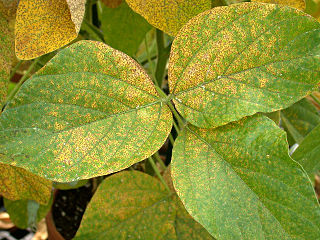
The curlew sandpiper is a small wader that breeds on the tundra of Arctic Siberia.

Soybean rust is a disease that affects soybeans and other legumes. It is caused by two types of fungi, Phakopsora pachyrhizi, commonly known as Asian soybean rust, and Phakopsora meibomiae, commonly known as New World soybean rust. P. meibomiae is the weaker pathogen of the two and generally does not cause widespread problems. The disease has been reported across Asia, Australia, Africa, South America and the United States.

Zeerust is a commercial town situated in Ngaka Modiri Molema district North West Province, South Africa. It lies in the Marico valley, approximately 240 kilometres northwest of Johannesburg. It lies on the N4, the main road link between South Africa and Botswana. There are large cattle ranches in the area, as well as wheat, maize, tobacco and citrus fruit farms. There are also fluorite and chromite mines in the vicinity. Tourism is also a developing industry.

Oudtshoorn Municipality is a municipality located in the Western Cape Province of South Africa. As of 2011, the population was 95,933.

The Olifants River,Lepelle, iBhalule or Obalule is a river in South Africa and Mozambique, a tributary of the Limpopo River. It falls into the Drainage Area B of the Drainage basins of South Africa. The historical area of the Pedi people, Sekhukhuneland, is located between the Olifants River and one of its largest tributaries, the Steelpoort River.
The R341 is a Regional Route in South Africa that connects the N12 at De Rust in the west and the N9 between Uniondale and Willowmore in the east. Just before reaching the N9, it meets the northern terminus of the R339

Europa-Park is a theme park in Rust, Baden-Württemberg, Germany. Covering a total area of 95 hectares, eighteen themed areas offer around one hundred rides, several shows, and thirteen roller coasters, the park includes six hotels, a camping site, a tepee village, a cinema and a conference center.

Acacia saligna, commonly known by various names including coojong, golden wreath wattle, orange wattle, blue-leafed wattle, Western Australian golden wattle, and, in Africa, Port Jackson willow, is a small tree in the family Fabaceae. Native to Australia, it is widely distributed throughout the south west corner of Western Australia, extending north as far as the Murchison River, and east to Israelite Bay. The Noongar peoples know the tree as Cujong.

Stem rust, also known as cereal rust, black rust, red rust or red dust, is caused by the fungus Puccinia graminis, which causes significant disease in cereal crops. Crop species that are affected by the disease include bread wheat, durum wheat, barley and triticale. These diseases have affected cereal farming throughout history. The annual recurrence of stem rust of wheat in North Indian plains was discovered by Prof. K.C. Mehta. Since the 1950s, wheat strains bred to be resistant to stem rust have become available. Fungicides effective against stem rust are available as well.

Wheat leaf rust is a fungal disease that affects wheat, barley, rye stems, leaves and grains. In temperate zones it is destructive on winter wheat because the pathogen overwinters. Infections can lead up to 20% yield loss, which is exacerbated by dying leaves, which fertilize the fungus. The pathogen is a Puccinia rust fungus. It is the most prevalent of all the wheat rust diseases, occurring in most wheat-growing regions. It causes serious epidemics in North America, Mexico and South America and is a devastating seasonal disease in India. P. triticina is heteroecious, requiring two distinct hosts.
The International Center for Agricultural Research in the Dry Areas (ICARDA), a member of CGIAR, supported by the CGIAR Fund, is a non-profit agricultural research institute that aims to improve the livelihoods of the resource-poor across the world's dry areas.

De Rust is a small village at the gateway to the Klein Karoo, South Africa. The name is Dutch and literally translates to "The Rest", referring to the town's original purpose of being a resting place for settlers en route through the challenging terrain of a nearby Swartberg gorge.

Ug99 is a lineage of wheat stem rust, which is present in wheat fields in several countries in Africa and the Middle East and is predicted to spread rapidly through these regions and possibly further afield, potentially causing a wheat production disaster that would affect food security worldwide. In 2005 the noted green revolution pioneer Norman Borlaug brought great attention to the problem, and most subsequent efforts can be traced to his advocacy. It can cause up to 100% crop losses and is virulent against many resistance genes which have previously protected wheat against stem rust.

The Elands River is a river in the former Transvaal area, South Africa. It is a tributary of the Olifants River, part of the Limpopo River basin.
The Rust de Winter Dam is a dam located on the Elands River, Limpopo, South Africa.

Hendri Christian Rust is a South African rugby union player for El Salvador in the División de Honor in Spain. His regular position is fly-half, but he can also play outside centre or fullback.

Rust en Vreugd, is a historic house and garden, located on Buitekant Street at the edge of the central business district of Cape Town, South Africa. It is one of the few remaining 18th-century buildings in the city. The Rust en Vreudg is home to the William Fehr Collection of pictorial Africana. It is a part of the Iziko Museums.
The Iziko Museums of Cape Town — an amalgamation of 12 national museums located near the Cape Town city centre. Iziko museums spheres – natural history, social history and arts.

Puccinia porri is a species of rust fungus that causes leek rust. It affects leek, garlic, onion, and chives, and usually appears as bright orange spots on infected plants.

Puccinia myrsiphylli is a rust fungus in the genus Puccinia, family Pucciniaceae, and is native to South Africa. It has been tested, introduced, and targeted in Australia and New Zealand as an effective biocontrol agent for Asparagus asparagoides, also known as bridal creeper.














